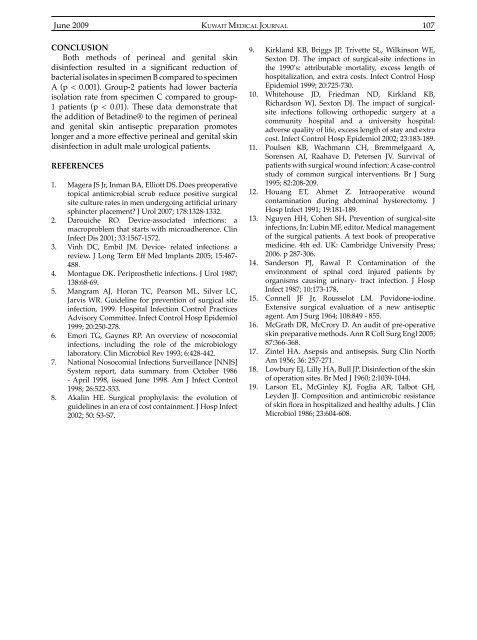June 09-41-2.indd - Kma.org.kw
June 09-41-2.indd - Kma.org.kw
June 09-41-2.indd - Kma.org.kw
You also want an ePaper? Increase the reach of your titles
YUMPU automatically turns print PDFs into web optimized ePapers that Google loves.
<strong>June</strong> 20<strong>09</strong>KUWAIT MEDICAL JOURNAL 107CONCLUSIONBoth methods of perineal and genital skindisinfection resulted in a significant reduction ofbacterial isolates in specimen B compared to specimenA (p < 0.001). Group-2 patients had lower bacteriaisolation rate from specimen C compared to group-1 patients (p < 0.01). These data demonstrate thatthe addition of Betadine® to the regimen of perinealand genital skin antiseptic preparation promoteslonger and a more effective perineal and genital skindisinfection in adult male urological patients.REFERENCES1. Magera JS Jr, Inman BA, Elliott DS. Does preoperativetopical antimicrobial scrub reduce positive surgicalsite culture rates in men undergoing artificial urinarysphincter placement? J Urol 2007; 178:1328-1332.2. Darouiche RO. Device-associated infections: amacroproblem that starts with microadherence. ClinInfect Dis 2001; 33:1567-1572.3. Vinh DC, Embil JM. Device- related infections: areview. J Long Term Eff Med Implants 2005; 15:467-488.4. Montague DK. Periprosthetic infections. J Urol 1987;138:68-69.5. Mangram AJ, Horan TC, Pearson ML, Silver LC,Jarvis WR. Guideline for prevention of surgical siteinfection, 1999. Hospital Infection Control PracticesAdvisory Committee. Infect Control Hosp Epidemiol1999; 20:250-278.6. Emori TG, Gaynes RP. An overview of nosocomialinfections, including the role of the microbiologylaboratory. Clin Microbiol Rev 1993; 6:428-442.7. National Nosocomial Infections Surveillance [NNIS]System report, data summary from October 1986- April 1998, issued <strong>June</strong> 1998. Am J Infect Control1998; 26:522-533.8. Akalin HE. Surgical prophylaxis: the evolution ofguidelines in an era of cost containment. J Hosp Infect2002; 50: S3-S7.9. Kirkland KB, Briggs JP, Trivette SL, Wilkinson WE,Sexton DJ. The impact of surgical-site infections inthe 1990’s: attributable mortality, excess length ofhospitalization, and extra costs. Infect Control HospEpidemiol 1999; 20:725-730.10. Whitehouse JD, Friedman ND, Kirkland KB,Richardson WJ, Sexton DJ. The impact of surgicalsiteinfections following orthopedic surgery at acommunity hospital and a university hospital:adverse quality of life, excess length of stay and extracost. Infect Control Hosp Epidemiol 2002; 23:183-189.11. Poulsen KB, Wachmann CH, Bremmelgaard A,Sorensen AI, Raahave D, Petersen JV. Survival ofpatients with surgical wound infection: A case-controlstudy of common surgical interventions. Br J Surg1995; 82:208-2<strong>09</strong>.12. Houang ET, Ahmet Z. Intraoperative woundcontamination during abdominal hysterectomy. JHosp Infect 1991; 19:181-189.13. Nguyen HH, Cohen SH. Prevention of surgical-siteinfections, In: Lubin MF, editor. Medical managementof the surgical patients. A text book of preoperativemedicine. 4th ed. UK: Cambridge University Press;2006. p 287-306.14. Sanderson PJ, Rawal P. Contamination of theenvironment of spinal cord injured patients by<strong>org</strong>anisms causing urinary- tract infection. J HospInfect 1987; 10:173-178.15. Connell JF Jr, Rousselot LM. Povidone-iodine.Extensive surgical evaluation of a new antisepticagent. Am J Surg 1964; 108:849 - 855.16. McGrath DR, McCrory D. An audit of pre-operativeskin preparative methods. Ann R Coll Surg Engl 2005;87:366-368.17. Zintel HA. Asepsis and antisepsis. Surg Clin NorthAm 1956; 36: 257-271.18. Lowbury EJ, Lilly HA, Bull JP. Disinfection of the skinof operation sites. Br Med J 1960; 2:1039-1044.19. Larson EL, McGinley KJ, Foglia AR, Talbot GH,Leyden JJ. Composition and antimicrobic resistanceof skin flora in hospitalized and healthy adults. J ClinMicrobiol 1986; 23:604-608.
















